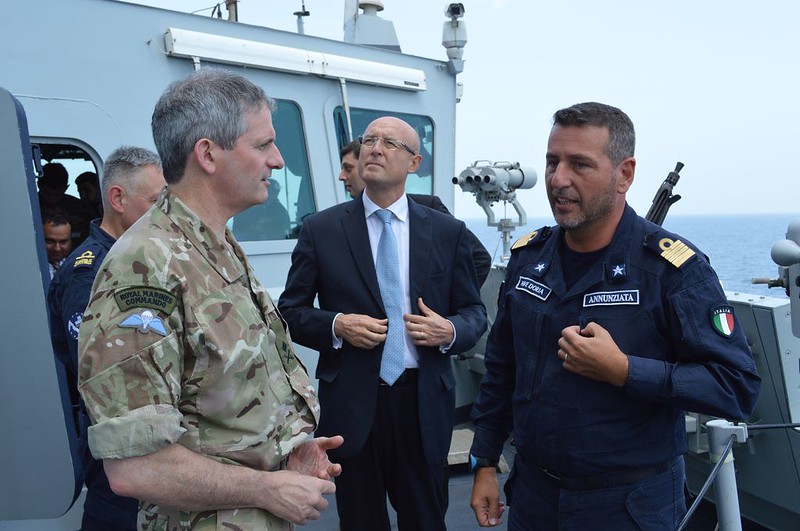By Brendan Flynn, National University of Ireland
Operation Atalanta (EU NAVFOR) has unquestionably grabbed the limelight as the EU’s most important contribution to combating piracy. However, that mission’s mandate ends in 2014, and while it may be extended it appears to be scaling down as the piracy epidemic off the coast of Somalia has much reduced. Does this mean the EU is no longer interested in anti-piracy? Not really, but perhaps the emphasis is shifting towards softer (and cheaper) maritime security initiatives.
This summer alone the EU’s Maritime Strategy has been published which includes anti-piracy as a key theme, although the document itself is a rather disappointing mish-mash of many concerns. Of more direct relevance has been the steady progress of a dedicated EU anti-piracy mission for the Gulf of Guinea the so-called CRIMGO initiative (Critical Maritime Routes Gulf of Guinea). This project is actually one of several “Crimson” initiatives which were pioneered since 2008 by the Commission Directorate for Development. These are tailored to specific trade routes, with ones for the Straits of Malacca, Indian Ocean, etc.
CRIMGO is very different to Operation Atalanta but rather closer to the EUCAP NESTOR mission. For one thing there is no question of any permanent naval patrols in West African waters by EU navies. Secondly, much of the action takes place on land. The core of CRIMGO is about training local maritime security and anti-piracy elites and developing capacities to tackle the problem locally. Note, there is no EU building up of the actual hard infrastructure to combat piracy, such as through transfers of vessels, aircraft, drones or others measures.
Instead what is being enhanced is the ‘soft’ security infrastructure: institutional cultures, legal norms, sharing of intelligence and know-how. Already several anti-piracy courses have been completed, graduating scores of personnel from local West African navies, coastguards, and other authorities. A regional information centre is planned for Yaoundé. The overall sums of money involved such efforts are small, and it raises the question of whether the EU prefers normative and inexpensive “soft” power at the expense of projecting credible force.
While West Africa is now gripped by the Ebola epidemic, the region has seen a recent scramble for influence over the anti-piracy issue. The Americans and Chinese have donated ships, in both cases to Nigeria, who is the pivotal state in the region and at the heart of the piracy problem. Multi-lateral naval exercises such as OBANGAME are not EU efforts but led by US Africa Command, while the appearance of a Chinese naval Taskforce off Lagos in spring of this year, conducting anti-piracy drills with the Nigerian navy, has surely pointed to just how competitive the market for maritime influence in West Africa has become.
Yet the EU’s relatively cheap focus on building up long-term relationships with local naval and maritime security elites in the littoral states may pay some dividends. On the one hand, it raises the salience of the anti-piracy mission with many mid-ranking officers in local forces. These will be future local leaders who have perhaps advanced their career specifically through the anti-piracy agenda. On the other hand, it can be surprisingly effective to tackle piracy on land through a developmental and (good) governance framework. Conversely, we know from the Somali piracy epidemic just how limited use of naval force at sea often was, when captured pirates were simply let go or could not easily be prosecuted. Supporting regional maritime security mechanisms and strengthening regional maritime security capacities, as envisioned in the EU Strategy on the Gulf of Guinea adapted in June this year, is key to counter piracy in the long run. For all these reasons, soft maritime security initiatives like CRIMGO make sense for the EU, although they also raise some thorny questions.
Chief of these is whether the EU should engage with the deeper roots of the West African piracy phenomenon, which seem to be closely tied to the overall fate of the Niger Delta. CRIMGO cannot be a counter-insurgency strategy, yet links between piracy and secessionist and other armed elements in the Delta are clear. There are also murky associations between pirates and armed factions who may enjoy connections with elements of local state security forces. Clearly there are limits to soft anti-piracy approaches in such cases, yet the answer to on-going piracy woes in West Africa and elsewhere is unlikely to be a replay of EUNAVOR, but rather a blend of softer maritime security policies, enhanced onshore governance, leavened with greater use of private and public vessel detachments. Deploying state of the art destroyers to find pirates, at a minimum cost of over one million dollars a month, is arguably both a rich man’s game and a mug’s game. Increasingly, the EU simply cannot afford to play either!
Resources and Further Reading
Basil, Germond. 2011. The EU’s security and the sea: defining a maritime security strategy. European Security 29 (4): 563-584.
EU Critical Maritime Routes Programme
EU Critical Maritime Routes Gulf of Guinea (CRIMGO)
EU Mission ATALANTA (Gulf of Aden)
EU Mission EUCAP NESTOR (Horn of Africa)
EU Strategy for the Gulf of Guinea
Riddervold, Marianne. 2014. ‘New threats – different response: EU and NATO and Somali piracy’. European Security 23 (4): 546-564.
About the author
Dr. Brendan Flynn is a lecturer in the School of Sociology and Political Science, National University of Ireland, Galway. His research interests include environmental policy, marine renewables and marine security.
Photo by European External Action Service
This commentary was originally published on Piracy Studies

